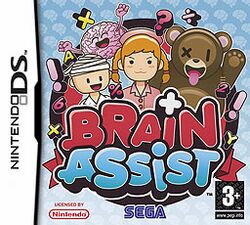Brain Assist
Topic: Software
 From HandWiki - Reading time: 2 min
From HandWiki - Reading time: 2 min
| Brain Assist | |
|---|---|
 | |
| Developer(s) | Japan Art Media[1] |
| Publisher(s) | Sega |
| Composer(s) | Seiichiro Matsumura Mariko Nanba |
| Platform(s) | Nintendo DS |
| Release | |
| Genre(s) | Puzzle, educational |
| Mode(s) | Single-player, multiplayer |
Brain Assist or Touch de Uno DS is a puzzle video game released for the Nintendo DS in Japan, North America, and the PAL regions. Studies in the 1960s demonstrated the lateralization of brain function. The left-brain hemisphere deals with sequential analysis - reasoning using language, mathematics, abstraction and reasoning. Memory is primarily stored in a language format. The right-brain hemisphere deals with auditory, visual, and spatial concepts (art, for example) dancing and gymnastics, which is what the game aims to stimulate in the player.
Reception
| Reception | ||||||||||||||||||||||||||||
|---|---|---|---|---|---|---|---|---|---|---|---|---|---|---|---|---|---|---|---|---|---|---|---|---|---|---|---|---|
| ||||||||||||||||||||||||||||
Brain Assist received mixed reviews from critics upon release. On Metacritic, the game holds a score of 53/100 based on 17 reviews, indicating "mixed or average reviews".[3] On GameRankings, the game holds a score of 53.89% based on 19 reviews.[2]
References
- ↑ "右脳能力チェックマシーン タッチ・デ・ウノー!DS". http://www.jam1989.co.jp/works/game00012.html.
- ↑ 2.0 2.1 "Brain Assist for DS". GameRankings. http://www.gamerankings.com/ds/936101-brain-assist/index.html. Retrieved 26 December 2017.
- ↑ 3.0 3.1 "Brain Assist for DS Reviews". Metacritic. https://www.metacritic.com/game/brain-assist/critic-reviews/?platform=ds. Retrieved 26 December 2017.
- ↑ DeVries, Jack (29 February 2008). "IGN: Brain Assist Review". IGN. Archived from the original on 3 March 2008. https://web.archive.org/web/20080303045637/http://ds.ign.com/articles/856/856155p1.html. Retrieved 26 December 2017.
- ↑ David, Mike (17 March 2008). "Brain Assist Review - Nintendo DS". GameZone. Archived from the original on 23 March 2008. https://web.archive.org/web/20080323141551/http://nds.gamezone.com/gzreviews/r34100.htm. Retrieved 26 December 2017.
- ↑ Kimber, Roy (18 April 2008). "Brain Assist Review". VideoGamer.com. https://www.videogamer.com/reviews/brain-assist-review. Retrieved 26 December 2017.
- ↑ Dodson, Joe (3 April 2008). "Brain Assist for DS Review". GameSpot. Archived from the original on 25 February 2009. https://web.archive.org/web/20090225174401/http://www.gamespot.com/ds/puzzle/touchdeunods/review.html. Retrieved 26 December 2017.
- ↑ Provo, Frank (4 March 2008). "Brain Assist review". GamesRadar. http://www.gamesradar.com/brain-assist-review/. Retrieved 26 December 2017.
- ↑ Balistrieri, Emily (26 February 2008). "Review: Brain Assist for DS on GamePro.com". GamePro. Archived from the original on 28 February 2008. https://web.archive.org/web/20080228191859/http://www.gamepro.com/nintendo/ds/games/reviews/164468.shtml. Retrieved 26 December 2017.
- ↑ Fahey, Rob (15 May 2008). "DS Roundup Review". Eurogamer. http://www.eurogamer.net/articles/ds-roundup_1?page=3. Retrieved 26 December 2017.
- ↑ Brice, Kath (28 March 2008). "Brain Assist review - DS reviews". Pocket Gamer. http://www.pocketgamer.co.uk/r/DS/Brain+Assist/review.asp?c=6110. Retrieved 26 December 2017.
External links
 |
 KSF
KSF